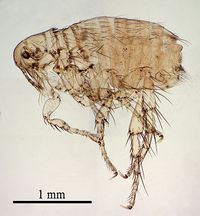Difference between revisions of "Ctenocephalides canis"
Jump to navigation
Jump to search
| (19 intermediate revisions by 2 users not shown) | |||
| Line 1: | Line 1: | ||
| − | {{ | + | {{unfinished}} |
| − | |||
| − | { | + | {| cellpadding="10" cellspacing="0" border="1" |
| − | | | + | | Also known as: |
| − | + | | '''Dog flea | |
| − | + | |- | |
| − | | | + | |} |
| − | | | ||
| − | | | ||
| − | |||
| − | |||
| − | |||
| − | |||
| − | | | ||
| − | |||
| − | [[Image:Ctenocephalides canis.jpg|200px|thumb|right|''Ctenocephalides canis'' <br> | + | |
| + | [[Image:Ctenocephalides canis.jpg|200px|thumb|right|''Ctenocephalides canis'' <br> Adam Cuerden 2007, Wikimedia Commons]] | ||
| + | |||
| + | ===Scientific Classification=== | ||
| + | |||
| + | {| cellpadding="10" cellspacing="0" border="1" | ||
| + | | Class | ||
| + | | Insecta | ||
| + | |- | ||
| + | | Order | ||
| + | | Siphonaptera | ||
| + | |- | ||
| + | | Family | ||
| + | | Pulicidae | ||
| + | |} | ||
==Hosts== | ==Hosts== | ||
| Line 22: | Line 27: | ||
==Identification== | ==Identification== | ||
| − | ''C. canis'' is very similar to ''[[Ctenocephalides felis| C.felis]]'' | + | ''C. canis'' is very similar to ''[[Ctenocephalides felis| C.felis]]''. The first genal spine is 0.5 times the length of the second, and ''C. canis'' has a more rounded head than ''C. felis.'' |
| − | |||
| − | |||
==Life Cycle== | ==Life Cycle== | ||
| Line 31: | Line 34: | ||
Under suitable conditions, the complete life cycle can take as little as 3 weeks. | Under suitable conditions, the complete life cycle can take as little as 3 weeks. | ||
| − | + | [[Category:Dog]] | |
| − | |||
| − | |||
| − | |||
| − | |||
| − | |||
| − | |||
| − | |||
| − | |||
| − | [[Category:Dog | ||
[[Category:Fleas]] | [[Category:Fleas]] | ||
| − | + | [[Category:To_Do_-_Max]] | |
| − | [[Category: | ||
Revision as of 10:09, 26 July 2010
| This article is still under construction. |
| Also known as: | Dog flea |
Scientific Classification
| Class | Insecta |
| Order | Siphonaptera |
| Family | Pulicidae |
Hosts
Dogs, cats, rabbits, rats, foxes and humans
Identification
C. canis is very similar to C.felis. The first genal spine is 0.5 times the length of the second, and C. canis has a more rounded head than C. felis.
Life Cycle
Again, very similar to C. felis. The eggs are produced soon after arrival on the host. They then hatch into larvae, which undergo two moults before entering the pupae stage. The pupae may remain dormant for a year or longer, and are stimulated to hatch by mechanical stimuli such as vibrations.
Under suitable conditions, the complete life cycle can take as little as 3 weeks.
